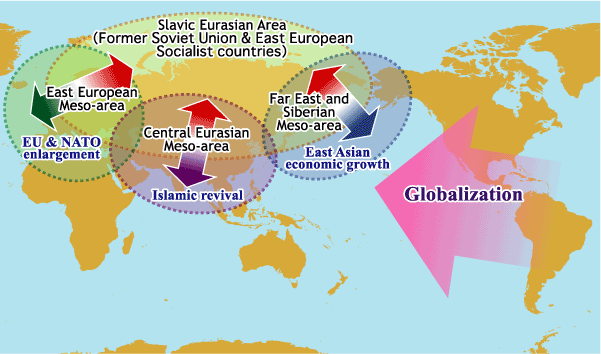|

Making a Discipline of Slavic
Eurasian Studies
The
Slavic Eurasian Region
The whole Slavic Eurasian region is often
called that of the transition economies or of post-communist states
but, while such terms may be appropriate for the current phase, they do
not appropriately express the self-identification of the people of
those countries or the geographical concepts employed by them. As yet,
however, there is no academic consensus on what terms we should use
instead. The term “Eurasia” is sometimes applied to the whole region.
However “Eurasia” is a geographical name that includes all of Europe
and Asia and, while it may be accepted among specialists as a sort of
“password”, it is not commonly used elsewhere. In this project we call
“Slavic Eurasia” those regions where the influence of Russia and Slavic
culture are strong and we hope to give this terminology a global
appeal.
Slavic Eurasia shares a common historical
heritage in socialism and in the influence of Russia, but at the same
time it is a fact that particular regions have continued to be formed
within that space. In the east, for example, Siberia and the Russian
Far East have strengthened economic relations with Japan, China and
Korea. To the south, Central Eurasia has received a complex of
cultural, political and economic influences from Islam, China and South
Asia. In the west of Slavic Eurasia, Eastern Europe has increased its
orientation toward Western Europe and the EU. Further sub-divisions are
also possible. For example, Central Eurasia can be divided into Central
Asia, the South Caucasus and southern Russia, the former Eastern Europe
into the Balkans (recently also called Southeast Europe) and East
Central Europe (Poland, Czech Republic, Slovakia and Hungary), and the
western parts of the former Soviet Union into the Baltic states and
others (Ukraine, Belorus, and Moldova). In this way the various regions
of Slavic Eurasia are divided according to their experience of change
following the breakdown of the socialist system.
Slavic
Studies across the World
When we look at the current state of Slavic
studies across the world, in the past under the name of Cold War
research the United States expended enormous sums of state money to
lead the world in studies of socialism. After the Cold War and the
“fall of the enemy” the objectives of this research disappeared and
Slavic studies in the US tended to be scaled down and diversify. In
Western Europe the trend to limit research to Eastern Europe and Russia
became stronger. With the development of globalization in the late
1990s and the beginning of the 21st century, however, Islamic movements
opposing globalization once again demonstrated the importance of Slavic
Eurasia which has many points of contact and overlap with the Islamic
world. In Europe and America opportunities for general research on this
region increased.
With respect to these global research trends,
the Slavic Research Center of Hokkaido University is taking a leading
role in supporting and developing a system of synthetic research on the
whole former socialist orbit within Slavic Eurasia. The present 21st
Century COE Research and Educational Project was begun on the basis of
this accumulated research and is an attempt to be the first in world to
propose analytical methods appropriate to the era of globalization.
|
















